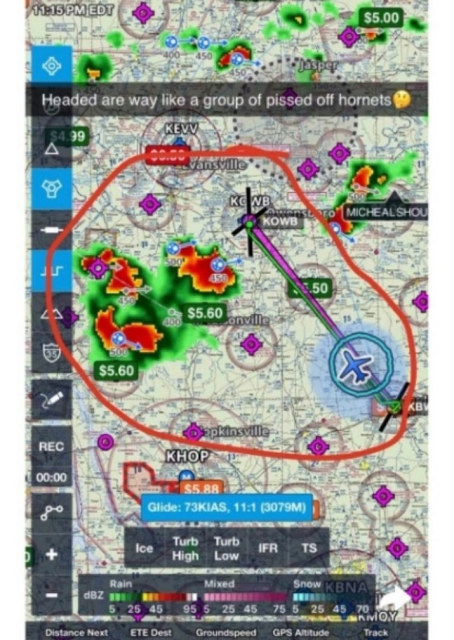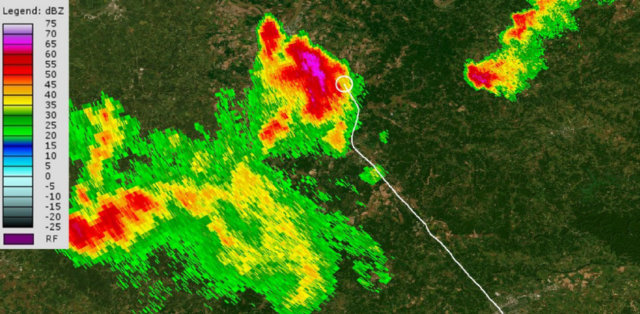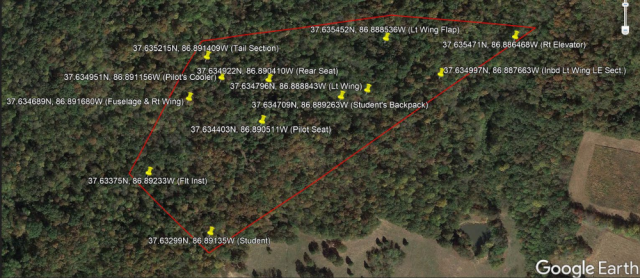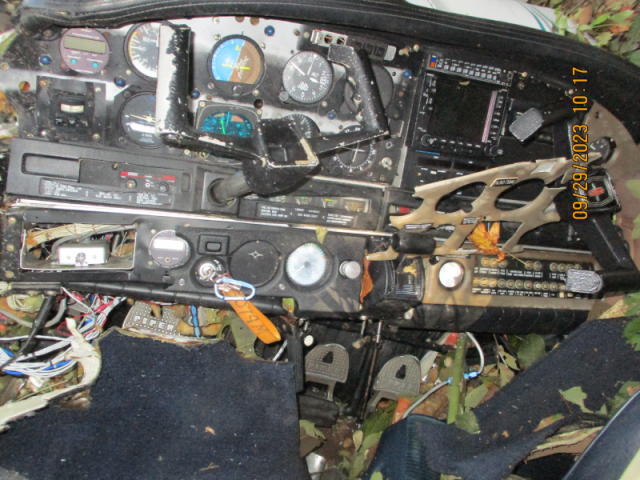I don’t like to be negative about flight instructors; it’s a difficult job that usually pays badly and requires superhuman levels of focus and patience. I had two amazing instructors who very much loved flying and were excited to share their passion with me.
But of course the fatal accidents caused by bad instructors are particularly chilling. There are some people who were probably unsafe as pilots and absolutely shouldn’t have been in charge of someone else’s instruction. This is one of those cases.
This video is a copy of the story that the instructor uploaded to Snapchat in stages before and during the flight that killed them both. The entire Snapchat story was just under two minutes long. All footage was recorded on the instructor’s phone, held in the instructor’s hand.
It is infuriating, so much so that I want to say here that it is perfectly OK not to watch the video. I will describe all of the pertinent pieces in the narrative below, which is based on the final report and docket, which were released by the NSTB last week.
It was the 27th of September, 2023. The aircraft was a Piper Cherokee, registered in the US as N3079M. The Cherokee is a single-engine low-wing aircraft designed for flying instruction and personal use. It has a reputation for being easy to fly and easy to recover from errors.
This particular Cherokee was a Piper PA-28-161, the Cherokee Warrior. It was manufactured in 1977 but had only 4,974 total hours. It had flown 29 hours since its last inspection three weeks earlier. There were no known issues with the aircraft.
The student pilot had been taking lessons at Eagle Aviation in Owensboro, Kentucky and had accrued 37 hours flight time there, all in the Piper Cherokee Warrior with the same CFI (Certified Flight Instructor). He had booked three hours of instruction for cross-country night flying cross-country from Owensboro to Bowling Green and back. This flight would complete the student’s night flight training requirements, allowing him to take the private pilot practical examination to gain his license.
The student’s primary CFI is colour blind and prohibited from flying at night; as a result, he was not able to accompany him for the night flight. He knew that his student would need to fly with another instructor in order to complete his flying requirements. He did not know that his student was flying that evening or who he was flying with. The flight instructor who took the student out did not reach out to discuss the student or the flight.
In fact, the student’s primary CFI knew the flight instructor who was flying with the student that evening. The flight instructor had initially trained at Eagle Aviation with the CFI when he first started flying in 2020. The CFI remembered that he’d warned him that if he wanted to fly for the airlines, he was going to have to be more careful with his social media presence. They had flown 24 hours together before the CFI became frustrated that the instructor was not studying. They agreed that he should take lessons elsewhere.
The instructor continued his training at ATP, a well-known flight school. He completed his flight instructor certificate about five months before the accident flight. He had worked at ATP as an instructor before returning to Eagle Aviation as an instructor.
At the time of the accident, the instructor was 22 years old. He held commercial and flight instructor certificates and was rated for multi-engine and single-engine aircraft. His total flight time was estimated at 447 hours across all aircraft, of which 20 hours were at night and 6.6 hours were in actual instrument meteorological conditions, that is, instrument flying in non-visual conditions.
It was the first time that the student had flown with this instructor. He was 18 years old.
They met at Owensboro Airport where the instructor uploaded his first video to Snapchat.
Snapchat videos can be up to ten seconds long; anything longer is split into ten second clips. A Snapchat story is a collection of clips that play in the order that they were uploaded and last for 24 hours. We have the full Snapchat story because a person who followed the instructor’s feed downloaded it as a single video file before it expired and forwarded the file to the NTSB.
The first clips were taken on the ground while the student pilot was doing his ground checks. The instructor points the camera at himself and has overlaid the video with text:
Me and this student would not get along if he was my full time student. I’ve seen faster at the special Olympics.
The video then switches to the back camera, showing the student pilot reviewing the checklist using the phone’s flashlight.
The next clip shows the instructor’s hand, tapping his fingers impatiently against the fuselage, again with text overlaid.
I don’t have to be up at 430am tomorrow or nothing. Let’s take our sweet ass time and have a conversation instead of getting this 3hr flight done.
At the end was an emoji of an expressionless face.
The camera view shows the student pilot sitting in the right seat of the parked aircraft, reading documents on his lap lit by his phone’s flashlight. The instructor taps his fingers against the fuselage again and finally says “Come onnnn” in a low voice before switching back to himself using the front camera, shaking his head in annoyance.
These were uploaded around 20:39 local time. Shortly thereafter they departed Owensboro Airport.
The next clip is from the interior of the aircraft, with the instructor in the right seat. The Warrior speeds along the runway and then takes off. There is text overlaid.
This is gonna be [a long] 3hr flight with forest gump jr. Let me tell you this he is not still the smartest in his class.
The flight was uneventful. The fourth clip shows the view outside of the aircraft from the right seat. They are flying straight and level with no abnormal engine noises or signs that anything might be wrong.
They landed at Bowling Green. The instructor checked the weather using ForeFlight. The meteorological briefing showed a convective SIGMET on their route. A SIGMET is issued to warn pilots of significant weather, in this case for thunderstorm activity with cloud tops up to 42,000 feet, wind gusts up to 50 knots and hailstones up to 1.25 inches in diameter (over 3 cm). All aircraft will avoid such areas, which are associated with severe turbulence and icing.
In other words, thunderstorms were forecast along their route that one did not want to be flying through under any circumstances, let alone in a light aircraft. For reference, it is about an hour’s drive from Bowling Green back to Owensboro.
That said, the flight was not necessarily unsafe; just that they needed to take special care to avoid the storms.
They departed Bowling Green at 21:55 local time.
The instructor uploaded two photographs to Snapchat. The first one is looking out over the right wing, with the city lights below clearly visible. The second photo is location stamped as Lover’s Lane Soccer Complex Bowling Green, KY. The location stamp is added by Snapchat for images uploaded with location services on.
The instructor had once again added text for context.
1.6 hours into the flight [instruction] of me giving it to him straight up.
Forest: I don’t mind you being hard on me I know I need it
Me thinking to myself did you really think I care if you minded [laughing emoji]. But what I actually said was, [we’re] flying planes not driving a car we can’t have these weak areas this far in the game
Some of the flight instruments were visible in this second photograph, showing a track of 215 and an altitude of slightly over 500 feet with wings level.
A third and final image was uploaded a bit later. This one was a screenshot of Foreflight with the time showing, which tells us exactly when the screenshot was taken: 22:15 local time, that is, twenty minutes after their departure from Bowling Green.
The screenshot shows the local weather with a large green area (precipitation) and three smaller red areas (high convective activity). The cloud tops of the convective activity are shown as between 40,000 and 50,000 feet.
The position of the Warrior and the expected flight path were overlaid onto the weather. Arrows showed that the storms were moving east, directly towards the Warrior’s flight path.
The screenshot had been edited to draw a circle around the flight track and the weather. The instructor had overlaid text onto the image before uploading.
Headed [our] way like a group of pissed off hornets.
The text was followed by a “thoughtful” emoji.

Caption: screen capture of a post to the flight instructor’s social media account.
The storms were moving towards their flight path at a speed of about 15 knots, which the instructor appeared to understand based on his caption. However, he may not have understood that radar images such as this one depict where the weather was at the time of image capture, which is not necessarily where the weather is.
Weather radar systems like ForeFlight use data from ground-based NEXRAD stations. This data goes through multiple processing steps before reaching the pilot’s screen: the radar sweep must be completed, transmitted to a processing center, combined with data from other radar sites into a “mosaic” image, then sent to the service provider, and finally delivered to the aircraft.
Each step adds delay. At the extreme, radar images can be up to 25 minutes out of date.
In this particular case, the weather image was about ten minutes old when he took the screenshot. The instructor clearly believed that they could fly past the approaching storms, which were moving at 15 knots from 280°. However, at the point when he took the screenshot of the weather system, the storms had travelled about 2.5 nautical miles east of where they appeared on the instructor’s display.
The storms were not headed their way like a group of pissed-off hornets. They were already there.

At 22:44, the student pilot called the controller at Evansville Approach Control. The entire exchange between the two pilots in the Warrior and the Evansville Approach controller took place over five minutes.
Student in N3079M: Evansville Approach, [this is] Warrior 3079 Mike level at four thousand five hundred [feet].
Evansville Approach: Warrior 3079 Mike, [this is] Evansville Approach, altimeter 2995. There is a large area of precipitation off of your nine o’lock to one o’clock, heavy to extreme precipitation.
The controller heard the sounds of the microphone keying up multiple times, followed by a short response.
Student: Altimeter 2995, Warrior 3079 Mike.
The Warrior continued northwest.
About two minutes later, the instructor called the controller and asked for IFR clearance to Owensboro. That is to say, they were not able to continue visually and the instructor was planning to take control of the flight from the student (or possibly already had) and fly on instruments.
Figure 2 : The aircraft’s ground track with weather radar information from Louisville, Kentucky at 22:45. The white circle shows the Cherokee’s position as 22:36, thirteen minutes before the crash, while the student pilot was still trying to fly visually.
The controller cleared the flight for instrument flight rules at 5,000 feet altitude and offered a vector of 360°, that is, a specific heading that they could follow which would take them east and hopefully get out of the weather.
Instructor in N3079M: 360. Very turbulent. we’re uh best we can.
Evansville Approach: November 79 Mike, actually, let’s make it a [heading of] 060°. You are already in the weather I told you about. Turn right, heading 060 [to] get you out of it.
Instructor: 060. 79 Mike
Evansville Approach: Fly heading 090°, due east bound.
Instructor: 090. Uh, you said five thousand feet for 79M, we’re getting blown around like crazy. We are at six thousand.
On the radar, the aircraft appeared to still be heading northwest.
Evansville Approach: November 79 Mike don’t worry about the altitude just [fly] 090 to get you out of that precipitation.
The Warrior entered a right circling turn.
Evansville Approach: November 79 Mike I’m showing you doing circles. I need you on a [heading of] 090 to get you out of that.
The controller is practically pleading for the Warrior to head east and get out of the storm.
Instructor: Roger that. We’re in pretty extreme turbulence. We are gonna get–
The transmission was cut off. The controller waited half a minute and then called again.
Evansville Approach: November 79 Mike
Instructor: …very extreme–
The transmission was cut off again.
Evansville Approach: November 79 Mike, if you’re able to hold a heading heading uh 160 or something to the south.
Evansville Approach: November 79 Mike, Approach.
Evansville Approach: November 3079 Mike, Evansville Approach.
The Cherokee continued in a right descending turn and then disappeared from radar at 22:49. Thirty minutes had elapsed since the instructor had posted the screenshot of the weather.
The Evansville Airport control tower alerted emergency dispatchers of a possible plane crash at 22:55. Several agencies in the area responded; however the aircraft wreckage wasn’t identified until 8:30 the next morning, when a searching drone found the debris field.
The debris field spanned 25 acres.
There was obviously no chance of survival.

Major components were scattered across the wooded hills around 1,000 feet northwest of that last radar return. The stabilator was torn at the hinges, found 1,500 feet away from the rest of the wreckage. The left wing’s aileron bellcrank had been wrenched off of its mount and pulled through the wing, showing forces far beyond what the aircraft was designed to handle.
This shows what the aircraft was going through when the instructor called to say that they were experiencing pretty extreme turbulence directly before losing contact. The Warrior was about 2,000 feet above the ground when it broke into pieces like a toy boat in a tsunami.
It is easy to be angry at the instructor, who was not just condescending and patronising towards his student for that evening but also disregarded the weather warnings and continued to route directly towards their destination, hoping to outrun the storms. But there is a bigger question here.
How does it happen that someone like this is entrusted with the safety of students?
We know that the instructor had studied at ATP flight school and then become a flight instructor there. However, during his time as an instructor, one of his students sent a complaint to ATP about the instructor. The student said that while they were in the cruise of an instructional flight, the instructor had pulled the circuit breakers from the fuel quantity gauge and the engine instrument gauge, disabling those gauges. The instructor also cut off the mixture for 2-3 seconds “with no intention of leaning”.
These are safety violations, causing unnecessary risk by deliberately disabling the critical safety systems of the aircraft. “Cutting the mixture” refers to stopping the fuel flow entirely, causing the engine to quit. To be clear, an instructor will often surprise students by simulating an engine failure in order to practice a response to an emergency situation. This is done by setting the engine’s power to idle. There is no reason or need to cut off the fuel and create an actual emergency in order to teach the student a lesson.
The reference to leaning, reducing the oxygen-to-fuel mixture to optimise the fuel to air ratio, was meant to make it clear that cutting off the mixture wasn’t a mistake.
The director of safety at ATP told the NTSB that, as a result of the student complaint, they terminated the instructor on the 16th of August 2023, a few weeks before the accident flight.
The instructor immediately joined Eagle Aviation. The man who hired him said that they needed an instructor and so hired him when he was released from employment at ATP. He said that he did not agree ATP’s reasoning for releasing the instructor. The instructor had told him that he surprised the student with an engine failure and the student complained about it, which led to ATP releasing the instructor. “He may have chopped the fuel to show that the airplane could continue to fly with the mixture pulled out.”
The student pilot’s original CFI said that he was aware that the instructor had been fired from ATP; the instructor had told him that it was because he’d pulled the mixture on a student who would not lean the mixture like he told him to.
At best, this presents a damning picture of an instructor who demonstrated to his superiors that he was willing to take unreasonable risks on student flights. The uploads to Snapchat, in which he was actively hostile to the student, shows a clear lack of respect and no real interest in helping students to become better pilots.
The NTSB’s final report concludes with the following probable cause:
The flight instructor’s improper decision to continue flight into a known area of thunderstorms, which resulted in an in-flight breakup.
Personnel issues: Decision making/judgment – instructor/check pilot Environmental issues: Thunderstorm – Decision related to condition Aircraft: Capability exceeded.

The instructor displayed several attitudes defined as hazardous by the FAA, most notably get-there-itis, driven by the pressure of having to “be up at 0430 the next day”. The NTSB report minimises these issues, choosing to focus on the pilot rather than the failure of the flight training system to screen or adequately manage an instructor who demonstrated bad judgment long before entering the cockpit of this flight.
There is no recommendation about instructor oversight, no guidance on employment verification for flight schools, no discussion of the gap between ATP’s termination and another school immediately hiring him. It was the instructor’s weather decisions that killed them both; however it was the flight school who put that inexperienced and frankly dangerous instructor in the right seat in the first place.
The family of the student pilot have filed a wrongful death lawsuit against both Eagle Aviation and ATP Flight Academy. This lawsuit focuses on the systemic issues, alleging both Eagle Aviation and ATP were aware of the instructor’s disregard for safety and professionalism and failed in their duty of care through negligent hiring, training, and supervision practices. Their case is still in progress. I hope that it has an impact where the NTSB report has not.